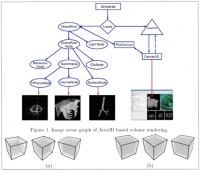Difference between revisions of "Volume Renderer"
From MIPAV
m |
m |
||
| Line 2: | Line 2: | ||
==Introduction== | ==Introduction== | ||
| − | + | [[File:VrSchemeSmall.jpg|200px|thumb|left|3-D texture proxy geometry. (a) Axis-aligned slices and (b) viewport-aligned slices.]] | |
The volumetric display of large datasets is a challenging task for medical imaging and visualization because of | The volumetric display of large datasets is a challenging task for medical imaging and visualization because of | ||
high memory requirements set by Java Virtual Machine. | high memory requirements set by Java Virtual Machine. | ||
| − | MIPAV volume renderer uses a Java3D scene graph-based framework that allows us to implement both the 3D texture-based and raycast-based volume renderers. An image scene graph approach used for rendering is shown in the figure | + | MIPAV volume renderer uses a Java3D scene graph-based framework that allows us to implement both the 3D texture-based and raycast-based volume renderers. An image scene graph approach used for volume rendering in MIPAV is shown in the figure on your left. |
| − | + | ||
| − | + | ||
Revision as of 14:41, 17 June 2013
This page is under construction.
Introduction
The volumetric display of large datasets is a challenging task for medical imaging and visualization because of high memory requirements set by Java Virtual Machine.
MIPAV volume renderer uses a Java3D scene graph-based framework that allows us to implement both the 3D texture-based and raycast-based volume renderers. An image scene graph approach used for volume rendering in MIPAV is shown in the figure on your left.
System Requirements
For system requirements, refer to MIPAV system requirements - GPU computing page.
References
For more information about MIPAV Volume Renderer, refer to the following posters and presentations
- "Visualization in MIPAV" presentation - download PDF
- "Java GPU Enhanced Multi-histogram Volume Rendering Framework for Efficient Bio-medical Visualization", by Ruida Cheng, Alexandra Bokinsky, Justin Senseney, and Matthew J. McAuliffe -
- "Java Based Volume Rendering Frameworks" by Ruida Cheng, Alexandra Bokinsky, Paul Hemler, Evan McCreedy, Matthew McAuliffe - download PDF
